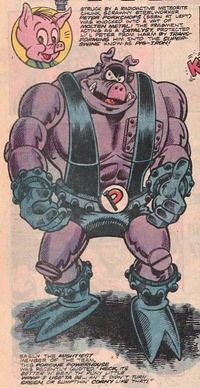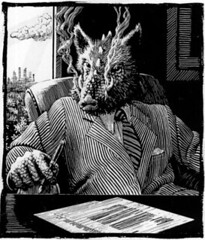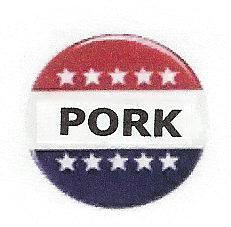
Superhero Pig Iron
Harrison Hogg, a Kentuckian who had moved to Cincinnati, was given a thousand acres by the government after the Revolutionary War on the present site of the city named after him. Hogg had, in the words of the original grant, “rendered valuable service during the war.”
The service in question was supplying pork, profitably, to the American militia via the Ohio River by an ingenious invention of Hogg’s called “pork paddleboats.” The boats began their journey in Cincinnati, and made their way northward to Pittsburgh, where the animals were slaughtered, smoked, and shipped still further north to the bedraggled and hungry American soldiers fighting in Pennsylvania, New Jersey and New York.
At first, Hoggville was only a refueling stop on the Ohio River, but Harrsion Hogg quickly figured how he could increase his profits by having his pork paddleboats begin their journey at Hoggville instead of Cincinnati. There was an exponential increase of pork in Hoggville, and travelers on river boats claimed they got wind of the river city long before they could see it. In 1846, an ordinance required piggeries to relocate outside city limits, but within ten years Hoggville’s city limits had expanded enough to take in the piggeries again.
Ironically, the only industry to speak of in Hoggville other than pork was pig iron. The shape of the sand molds used in smelting pig iron resembles a sow suckling her piglets, which is how the brittle iron produced by the process got its name. When Hogg laid out the platte for Hoggville, he chose not the traditional square but the irregular shape of the pig iron molds, because by that time swine, and everything associated with them, began to take on a mystical character for the Hoggs, like the trowel and hammer for the Masons.
Because Hogg’s pork was foul-tasting and hard to chew, the soldiers nicknamed it “pig iron.” According to one legend, Washington’s starving troops at Valley Forge refused eat their Hogg pork. “Beef, beef . . .” the soldiers reportedly pleaded with the quartermaster. One soldier who did eat his Hogg ration at Valley Forge was Oliver Tidwell, of Titusville, New York, a young schoolmaster. He became delirious for days after eating his rations. He later claimed that the apostle Peter appeared to him in a vision, chastising him for eating pork. “You must not eat pigs or touch their carcasses; they are unclean for you,” St. Peter told Titus. “Do not listen to those who say that Jesus did away with the prohibition against pork,” St. Peter added. “Do you think our Savior would eat pork chops? No, no, never! Go forth and tell the nation, ‘Pork is an abomination!’”
For the rest of his life, Tidwell was a zealous anti-pork crusader. As a schoolmaster, he had been a Deist, with a Thomas Paine pamphlet in his pocket even while he was in his delirium. But after the war, he became a deacon in the Titusville church and established an organization, Christians Opposed to Pork, or COP, publishing a pamphlet, “The Abomination of Pork as Revealed in a Delirium at Valley Forge, December 1777.” Opposed to the separation of church and state, Tidwell called on the framers of the Constitution to include an article prohibiting pork. In an eerie foreshadowing of contemporary history, Tidwell had predicted in his pamphlet that the Islamic prohibition of alcohol and pork would give the followers of Mohammed a decisive advantage over Christians in the centuries ahead. “Rum and pork will be the ruination of the American republic,” Tidwell prophesized.
Tidwell had never forgotten that Hoggville was the city that supplied the pork that had made him deathly ill, so he made a trip there in the summer of 1802. In a COP convention in Albany, New York, in 1804, he denounced Hoggville as “that wicked city on the Ohio River.” He accused its inhabitants of capitulating to pork with all the accompanying physical, moral, and spiritual consequences. “The people of Hoggville eat so much pork that they have begun to look and act like pigs,” he wrote. Tidwell went so far as to claim that Catholic children in a Hoggville parochial school were being taught in pig-latin, which claim was derided in newspapers and pulpits of Hoggville as the ravings of a madman. When Tidwell read an editorial that had been published in the Hoggville Times on July 4th, 1801, the twenty-fifth anniversary of the birth of the nation, he said that independence was precisely what the people of Hoggville lacked; they were always looking for a handout, such as the government’s original land grant to Hogg.
Tidwell accused Hoggville of pagan porcine-centered practices, everything from serving stuffed pig at Thanksgiving to a bridegroom’s obligatory squeezing of the testicles of the larger-than-life-sized pig that stood in front of the Hoggville town hall at midnight on the last full moon before his wedding day. In other towns, people put statues of deer on their lawn; in Hoggville, Tidwell said, they put statues of pigs. The Hogg family was rumored to have invested most of its wealth in gold, which it melted down and cast in the form of pigs. Always inclined to believe the worst of Hoggville, Tidwell had no doubt the rumor was true. “They worship not the golden calf but the golden pig,” he said.
Whether of not the rumors about the gold pigs were true, in life as in death, pigs were on everyone’s mind in Hoggville, from kids in cribs to the aged on their deathbed. The imposing Hogg Mausoleum in the Hoggville cemetery featured not a golden but a
 bronze statue of a sow suckling eight piglets. After Hoggville children said their prayers at bedtime, they pleaded with their parents to play “This little piggy went to market.” Because it was not unusual for children in their early teens to be still attached to the “little piggy” bedtime ritual, the minister of the Presbyterian Church preached a sermon on the question: “At what age should parents stop playing ‘This Little Piggy’ with their children?” Rumor had it that the marriage of a Hoggville pork heiress had ended in divorce because her husband’s sexual interest in her had consisted solely of his playing “This little piggy” with her toes.
bronze statue of a sow suckling eight piglets. After Hoggville children said their prayers at bedtime, they pleaded with their parents to play “This little piggy went to market.” Because it was not unusual for children in their early teens to be still attached to the “little piggy” bedtime ritual, the minister of the Presbyterian Church preached a sermon on the question: “At what age should parents stop playing ‘This Little Piggy’ with their children?” Rumor had it that the marriage of a Hoggville pork heiress had ended in divorce because her husband’s sexual interest in her had consisted solely of his playing “This little piggy” with her toes.Other industries emerged in Hoggville in the 1800s, but they were all pig-related. The finely crafted Krautmitz pig-skinned gloves, which reportedly graced the h
 ands of Queen Victoria, were made by a German-American Hoggville company. And Rampant Sporting Equipment, owned by a French-American family, was once as familiar a name in sporting equipment as Spaulding and Wilson later were. In the late 1800s, Rampant footballs, made of pigskin, were passed and dropped-kicked all over the country, from sandlot scrimmages to the annual Harvard-Yale game. The Hoggville Pigskins, a local semi-professional football team sponsored by the Rampant Co., had a live pig as its mascot. (Photo at right of 1910 Pigskin captain holding Rampant pigskin football.) The poet Carl Sandburg dubbed Chicago “Hog-Butcher for the World,” but Hoggville satisfied itself with the slogan that appeared on the Hogg Co. pork products that were shipped all over the country: “From California to New York: Hogg’s is America’s Favorite Pork!”
ands of Queen Victoria, were made by a German-American Hoggville company. And Rampant Sporting Equipment, owned by a French-American family, was once as familiar a name in sporting equipment as Spaulding and Wilson later were. In the late 1800s, Rampant footballs, made of pigskin, were passed and dropped-kicked all over the country, from sandlot scrimmages to the annual Harvard-Yale game. The Hoggville Pigskins, a local semi-professional football team sponsored by the Rampant Co., had a live pig as its mascot. (Photo at right of 1910 Pigskin captain holding Rampant pigskin football.) The poet Carl Sandburg dubbed Chicago “Hog-Butcher for the World,” but Hoggville satisfied itself with the slogan that appeared on the Hogg Co. pork products that were shipped all over the country: “From California to New York: Hogg’s is America’s Favorite Pork!”The most famous and profitable Hogg product was pork rinds. Though the English claimed pork rinds originated in the so-called Black Country, in the Midland coal mining area, the Hoggs claimed they were the inventors. Hogg pork rinds came in two varieties, Hogg Regular and Hogg Hairy. Pork rind aficionados would eat nothing but the Hairy variety, for they claimed pig hairs added a subtle spiciness to the rinds.
Another Hogg product, Hogg Deviled Ham, was rumored to be the snack of choice in houses of prostitution, as prunes and figs had been in brothels in Shakespeare’s London. It was presumably for that reason that the sale of Hogg Deviled Ham was banned in Boston. Because of these alleged unsavory associations, Tidwell said that if salvation was Jesus’s gift to mankind, pork was the devil’s. The Women’s Christian Temperance Union denounced “demon rum,” but COP condemned “demon pork.”
Harrison Hogg II insisted that if the devil was responsible for anything, it was not pork but unions. When the Meatcutter’s Amalgamated Union attempted to organize the Hoggville workers in the early 1900s, Harrison II blamed the trouble on socialist agitators from Youngstown. The Hoggs, he said, had always been givers, not takers, Good Samaritans, not Scrooges. He pointed out that his grandfather had begun the practice of personally distributing smoked hams to the poor at Christmas. Harrison II continued the tradition, but he was dogged by accusations that Hoggville’s poor, like the soldiers at Valley Forge, got only tainted meat.
The prosperity pork brought to Hoggville seemed like it would go on forever. Republicans and Democrats united to make Hoggville a one-party town: at election times, people sported only the Pork button. Well into the 1900s, Hoggville continued its love affair with pigs. The Hoggville Pigskins adopted a live pig as their mascot, and the
 Chamber of Commerce adopted Porky Pig as the city’s unofficial municipal logo. A Porky Pig cartoon festival was held each May at the Majestic Theater, which served free “Porkcorn,” a Hogg specialty item that popped like corn when heated but was actually another variation of pork rinds. The smell of Hogg Porkcorn was always in the air during the Miss Pigtail contest, for girls sixteen and under, which was held every Fourth of July. Where else in American could you find lard shakes, pig’s knuckle sundaes, and chitlin splits served at the local malt shop?
Chamber of Commerce adopted Porky Pig as the city’s unofficial municipal logo. A Porky Pig cartoon festival was held each May at the Majestic Theater, which served free “Porkcorn,” a Hogg specialty item that popped like corn when heated but was actually another variation of pork rinds. The smell of Hogg Porkcorn was always in the air during the Miss Pigtail contest, for girls sixteen and under, which was held every Fourth of July. Where else in American could you find lard shakes, pig’s knuckle sundaes, and chitlin splits served at the local malt shop?In the twentieth century, Hoggville adopted a patron Superhero named Pig Iron. From infancy onward, children were told the bedtime story of how a lackadaisical little pig named Peter Porkchop fell into a vat of molten pig iron and emerged an indestructible superhero. Every boy in Hoggville grew up collecting Pig Iron comic books. Superman, Batman, Spiderman, Captain Marvel – all played second-fiddle to the Swine of Steel, the Porcine Powerhouse, and the Swill Billy, to list a few of the nicknames by which Pig Iron was affectionately known in Hoggville.
Hoggville’s Decline
All things, the bad as well as the good, must come to an end. Around 1950, Hoggville began to decline economically. That was about the time the American diet began to change. The whole country was becoming cholesterol conscious, but in Hoggville cholesterol became a dirty word. Children who used it were made to eat a teaspoon of lard. But it was not just cholesterol. Footballs changed shape, no longer resembling a cross between a basketball and a football; and, more to the point, footballs were no longer made of pigskin. The long-lived Queen Victoria had eventually passed away and so did the fad for pigskin gloves. Kidskin was in. Pigskin was out, for footballs, wallets, belts, and saddles. For the cholesterol and calorie conscious, beef jerky became the healthy alternative to pork rinds. In time, as hard as it was for local residents to believe, the Hogg plant closed, moving its operations to a Maquiladora in Mexico.
Main Street storefronts were shuttered. Pig Out, the popular Main St. drive-in restaurant with an exclusively pork menu and a 1950s decor, served its last pig-in-a-blanket on Labor Day, 1978. By 1980, the population of Hoggville had dwindled to half what it had been fifty years earlier. It was in 1980 that a lawyer, a developer, and a couple of local politicians concocted a real estate scam under the guise of a mall that they claimed would revive downtown Hoggville. But nothing came of it except a string of antique/junk shops, with clever names like Pig-in-a-Poke, Higgledy-Piggledy and the Pig Sty. Pig-related relics of Hoggville’s prosperous past could be seen dimly, through unwashed cracked glass store fronts, cluttering the display area – piggy banks, lawn pigs, stacks of Pig Iron comics, life-sized cut-outs of Pig Iron himself, a painting titled “Pignacious,” of a pig in trunks and boxing gloves, yellowing photos of Porky Pig Festivals, and lumps of pig iron that once had served as centerpieces on dining tables. Locally, Main Street became known as Pig Alley after prostitutes and drug dealers drifted into the depressed city. A Baptist minister denounced Main St. in a radio sermon with a biblically inspired name: “Route 666,” which he pronounced “Route Sex-Sex-Sex.”
Government Assistance
“The Lord never closes one door that he doesn’t open another,” is a homily that would seem to apply to Hoggville, for having lost its pork foundation, the city, in the second half of the twentieth century, created another in the form of political pork. How that came about is complicated, but the simple explanation was Bigby Rampant Hogg, a descendant of Harrison Hogg on his father’s side and of the Rampants on his mother’s. “Biggie,” as he had been called as a boy, and “Big” as he was known as a man, was south-central Ohio’s perpetually reelected choice in the U.S. House of Representatives. By the time Lyndon Johnson declared war on poverty, “Big” Hogg was the Republican Minority Leader and a poker playing buddy of the President. Hogg was as successful at providing pork projects for his Hoggville congressional district as his ancestors had been at providing pork products for America. In the so-called War on Poverty, Hogg played General Patton to Johnson’s General Eisenhower, winning repeated legislative victories for his depressed Ohio Congressional district.
There was a catch , however. If the War Against Poverty was ever won, Hoggville would lose. Hoggville succeeded only by continuing to fail, for the worse conditions in Hogg’s congressional district were, the easier it was for him to persuade the President and the Democrats in Congress to go along with his many pet pork projects, as he in return went along with theirs. But the pork had to be dispensed in such a way that it did not end his district’s privileged status as one of the poorest in Ohio. Neighborhoods of Hoggville had to continue to deteriorate. The population had to continue to decline. And the rates for crime, drug dealing, and prostitution had to keep rising even as the public dollars that were supposed to reduce them were pumped into the city.
“Porkenomics”
The solution to “Big” Hogg’s problem was to design pork projects so that it was not the poor but the relatively few well-to-do in Hoggville who profited from them. The decline of Hoggville had produced more than one millionaire among the bankers, lawyers and developers. The trick was to get dollars targeted for the poor to somehow trickle up to them. It was what a young reporter for the Hoggville Times dubbed “trickle up porkenomics,” a phrase he used in the company of his cynical buddies over a beer at a local watering hole but that he would never have used in the Times.
Hoggville became addicted to “Trickle-up porkenomics.” Risk was virtually eliminated from economic life. Only fools started a business without grants, subsidies, low-interest loans, tax breaks, or without an “entrepreneurial package” from some state or federal agency. In an example of Orwellian doublespeak, a federal agency designated Hoggville an “Entrepreneurial Zone,” or an “EZ,” for short. The cynical might say “Entrepreneurial Zone” was a euphemism for “Welfare Zone,” the kind of zone, incidentally, where existing businesses kept out other businesses that might compete with it for customers and for government dollars. It was all so “EZ,” so to speak. This kind of thing was going on in other urban areas in the so-called Rust Belt states, of which Congressman Hogg claimed Ohio was the rustiest. Just as the government had stepped in with acronymic programs like the WPA, FHA and NRA during the 1930s, the federal government from the 1960s on played the rich uncle by sending millions of dollars through programs such as EZ to private “non-profit” corporations known as Community Improvement Corporations, which in turn redistributed the millions to the privileged few to invest in faltering or startup businesses.
Few of the government-hatched businesses in Hoggville succeeded. When the government is the sperm donor, the result is usually a miscarriage. Main St. became “the street where businesses go to die.” In Hoggville, the failure of these new “enterprises” were as commonplace as a bowel movement, and those rare ones that did succeed made no noticeable difference in the high unemployment rate.
Hoggville suffered not just from trickle-up but also from “half-baked” porkenomics, for just as undercooked pork could carry the debilitating larvae of Trichinella spiralis, which migrate into the muscles of humans who eat contaminated pork, so did pork dollars end up destroying the moral and ethical fiber of Hoggville. Initiative went out the window, inventiveness went down the drain, and accountability up in smoke. Instead of pulling themselves up by their own bootstraps, local “entrepreneurs” supported themselves with government jockstraps. Instead of competing for customers, business people in Hoggville tended to collude with each other for government dollars. Instead of solving problems, they swept them under the rug. Cronyism replaced merit as the criteria for advancement. When outsiders moved to Hoggville, they learned that if they wanted to fit in, they couldn’t afford to keep whatever ethical and moral standards they might have brought with them. If they did not become team-players in the crooked game, they were benched or fired.
The least successful gravitated to public office and did the bidding of the unelected clique of millionaires. An important qualification for mayor appeared to be not having succeeded at anything. Along with businesses without competition, the city was cursed with government without ethics, religion without good works, schools without study, courts without justice, hospitals without cures, and lives without meaning.
All public institutions in Hoggville appeared infected by porkenomics, or the managerial equivalent of Trichinella spiralis. The hospital and local state university were the recipients of many millions of public dollars funneled to them by Congressman Hogg. But when measured by national and state standards, those institutions were shown to be near the bottom, just as the city, in regard to crime, drug use, and prostitution, was near the top.
Glory of Hoggsville
The glory of Hoggsville is that it has never been without pork opponents, of both sexes, and of various ages, races, and party affiliations, who have carried on heroically from generation to generation. At times they have been a handful; at others they have
 numbered in the hundreds. Sometimes, they have been dismissed as misfits, malcontents, and vegetarians. At other times, they have been denounced as dangerous enemies of society. In the 1800s, they were accused of being COPs, secret members of Titus Tidwell’s Christians Opposed to Pork group. A hundred years later, in the 1950s, in the McCarthy era, the reformers were accused of being communists and queers, and of having ruined Hoggville by their un-American deprecation of pork. Then, more than a half a century later, at the beginning of the new millennium, in keeping with current fads, the reformers were accused of being domestic terrorists, as if they were allied to Islamic fanatics.
numbered in the hundreds. Sometimes, they have been dismissed as misfits, malcontents, and vegetarians. At other times, they have been denounced as dangerous enemies of society. In the 1800s, they were accused of being COPs, secret members of Titus Tidwell’s Christians Opposed to Pork group. A hundred years later, in the 1950s, in the McCarthy era, the reformers were accused of being communists and queers, and of having ruined Hoggville by their un-American deprecation of pork. Then, more than a half a century later, at the beginning of the new millennium, in keeping with current fads, the reformers were accused of being domestic terrorists, as if they were allied to Islamic fanatics.Until recently, pork opponents have struggled at a great disadvantage. The means of publication were always in the hands of the privileged few. The newspapers and radio stations were owned or controlled by the privileged. Reformers in Hoggville had to be satisfied with letters-to-the editor and mimeographed material distributed by hand, like samizdat material in the Soviet Union. The refusal of several council members to go along with the mall scam in 1980 resulted in a media-driven campaign that led to their removal from the office. A parade down Main Street denouncing the council members as “enemies of the people” had all the earmarks of a Ku Klux Klan rally, of which there had been several in Hoggville in the late 1970s. In Hoggville, people’s perceptions of what was what was heavily influenced if not dictated by the local media.
But that has changed dramatically in the last twenty years. An electronic revolution has democratized communication. Anyone with a computer and internet access has the potential to communicate with someone on the other side of the world or on the other side of Hoggville. The local media no longer have a monopoly on the news.
Now pork is a metaphor, representing all that is swinish in Hoggville – the lust for money, the plundering of the common weal, the debasement of local politics, the pollution of the environment, the eminent domaining of neighborhoods, the bulldozing of the past, the institutionalization of incompetence, the loss of initiative– all the things that motivate the reformers to do what they do and say what they say, day after day, year after year, only now what they are doing and saying is not a secret. Anyone can read it on the internet. The genie is out of the bottle and is not going to be put back anytime soon, if ever, and Hoggville may never be the same. Not even Pig Iron will stop them.